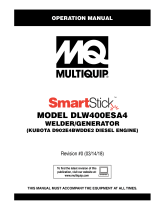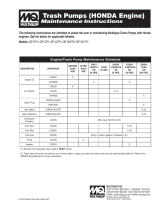
GAW-135H DC WELDER/AC GENERATOR — OPERATION MANUAL — REV. #1 (06/23/04) — PAGE 11
GAW-135H — RULES FOR SAFE OPERATION
■
NEVER run engine without air cleaner. Severe engine damage
may occur.
■
ALWAYS read, understand, and follow procedures in
Operator’s Manual before attempting to operate equipment.
■
ALWAYS be sure the operator is familiar with proper safety
precautions and operation techniques before using generator.
■
NEVER leave the generator unattended, turn off engine when
unattended.
■
Unauthorized equipment modifications will void all
warranties.
■
ALWAYS ensure generator is on level ground before use.
■
Become familiar with the components of the generator before
operating.
■
ALWAYS replace any worn or damaged warning decals.
■
ALWAYS make sure generator is properly grounded to a
suitable earth ground (GROUND ROD).
■
NEVER use gas piping as an electrical ground.
■
DO NOT place hands or fingers inside generator engine
compartment when engine is running.
■
NEVER let power cables or cords
lay in wate
r.
■
NEVER
stand in water
while AC power from the generator
is being transfer to a load.
■
NEVER use a defective or frayed power cable. Check the
cable for cuts in the insulation.
■
NEVER use a extension cord that is frayed or damaged where
the insulation has been cut.
■
ALWAYS make certain that proper extension cord has been
selected for the job See Table 3.
■
The electrical voltage required to operate the generator can
cause severe injury or even death through physical contact
with live circuits.
Turn all circuit breakers OFF before
performing maintenance on the generator.
■
High Temperatures – Always stop engine and allow the
engine to cool before adding fuel, oil or performing service
and maintenance functions. Contact with
hot
components can
cause serious burns.
■
NEVER disconnect any
"emergency or safety devices"
.
These devices are intended for operator safety. Disconnection
of these devices can cause severe injury, bodily harm or even
death! Disconnection of any of these devices will void all
warranties.
■
ALWAYS be sure the operator is familiar with proper safety
precautions and operations techniques before using generator.
■
ALWAYS make sure that electrical circuits are properly
grounded
per the
National Electrical Code
(NEC) and local
codes before operating generator. Severe
injury
or
death!
by
electrocution can result from operating an ungrounded
generator.
■
ALWAYS store equipment properly when it is not being used.
Equipment should be stored in a clean, dry location out of the
reach of children and un-authorized personnel.
■
ALWAYS read, understand, and follow
procedures in Operator’s Manual before
attempting to operate equipment.
WELDING SAFETY
■
ALWAYS remove any flammable materials in the vacinity of
the generator/welder where flying sparks may come in contact.
The possibility exists of a fire or an explosion which can
damage the equipment and thus cause bodily harm even
death!
■
High current generated from the welder can affect some
pacemakers. CAUTION, personnel who wear pacemakers
should consult their doctor before operating the welder.
■
When welding or watching, use a hand shield
or welding helmet fitted with the proper shade
filter.
■
ALWAYS wear safety glasses with side shields or face shield
Remember flying pieces of metal or dirt can injury eyes.
Maintenance Safety
■
NEVER lubricate components or attempt
service on a running machine.
■
ALWAYS allow the machine a proper amount
of time to cool before servicing.
■
Keep the machinery in proper running condition.
■
Fix damage to the machine immediately and always replace
broken parts, or missing decals.
■
Dispose of hazardous waste properly. Examples of potentially
hazardous waste are used motor oil, fuel and fuel filters.
■
DO NOT use food or plastic containers to dispose of
hazardous waste.
■
DO NOT pour waste, oil or fuel directly onto the ground,
down a drain or into any water source.
■
Removing the engine oil drain plug while
the engine is hot will result in hot oil to gush
out of the oil drain plug, therefore causing
severe scalding to any persons in the general
area of the generator.




























